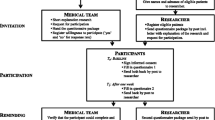Abstract
Goals of work
The goal of this study is the determination of key themes to aid the analysis of qualitative data collected at three cancer support centres in England, using the Measure Yourself Concerns and Wellbeing (MYCaW) questionnaire.
Patients and methods
People with cancer who use complementary therapies experience and value a wide range of treatment effects, yet tools are urgently required to quantitatively measure these outcomes. MYCaW is an individualised questionnaire used in cancer support centres providing complementary therapies, scoring ‘concerns or problems’ and ‘well-being’ and collecting qualitative data about other major events in a patient’s life and what has been most important to the patient. Content analysis on 782 MYCaW questionnaires from people at these cancer support centres was carried out. The ‘concerns,’ ‘other things going on in their life’ and ‘important aspects of centre’ were thematically categorised and externally validated by a focus group, and the inter-rater reliability was calculated.
Main results
Clinical information from a cancer patient’s perspective was collected that is not measured on standard quality-of-life questionnaires; furthermore, some themes acknowledge the multi-faceted aspects of complementary and alternative medicine provision, rather than information only relating to the therapeutic intervention. Categories for qualitative MYCaW analysis have been established providing a tool for future research and/or service delivery improvement within cancer support centres such as these.
Conclusions
The established themes provide a framework to aid analysis of qualitative aspects of complementary therapy care for people with cancer, improving our understanding of how the patient’s cancer experience can be aided by complementary therapies in specialised cancer centres.





Similar content being viewed by others
Notes
The inclusion criteria category information and instructions for new users can be accessed on the MYMOP website: http://www.bristol.ac.uk/hsrc/research/other/mymop.
References
Armstrong D, Gosling A, Weinman J, Marteau T (1997) The place of inter-rater reliability in qualitative research. Sociology 31:597–606
Barry C, Barry CA, Britten N, Barber N, Bradley C, Stevenson F (1999) Using reflexivity to optimise teamwork in qualitative research. Qual Health Res 9:26–44
Bowling A (1995) Measuring disease. A review of disease-specific quality of life measurement scales. Open Univ. Press, Buckingham, p 21
Ernst E, Cassileth BR (1998) The prevalence of complementary and alternative cancer: a systematic review. Cancer 53:2736–2740
Long AF, Mercer G, Hughes K (2000) Developing a tool to measure holistic practice: a missing dimension in outcomes measurement within complementary therapies. Complement Ther Med 8:26–31
Meenan R (2001) Developing appropriate measures of the benefits of complementary and alternative medicine. J Health Serv Res Policy 6:38–43
Molassiotis A, Fernadez-Ortega P, Pud D, Ozden G, Scott GA, Panteli V et al (2005) Use of complementary and alternative medicine in cancer patients: a European survey. Ann Oncol 16:665–663
Moris J (1991) Measurement of quality of life: how to choose an appropriate test. Cancer Topics 8:75–76
Paterson C (2004) Seeking the patient’s perspective: a qualitative assessment of EurQol, COOP-WONCA charts and MYMOP. Qual Life Res 13:871–881
Paterson C (2005) How to involve consumers in your research team. Complement Ther Med 13:61–64
Paterson C, Britten N (2000) In pursuit of patient-centred out-comes: a qualitative evaluation of MYMOP, Measure Yourself Medical Outcome Profile. J Health Serv Res Policy 5:27–36
Paterson C, Thomas K, Manasse A, Cooke H, Peace G (2006) Measure Yourself Concerns and Wellbeing (MYCaW): an individualised questionnaire for evaluating outcome in cancer support care that includes complementary therapies. Complement Ther Med 15:38–45
Peace G, Manasse A (2002) The Cavendish Centre for integrated cancer care: assessment of patients’ needs and responses. Complement Ther Med 10:33–41
Risberg T, Kaasa S, Wist E, Melsom H (1997) Why are cancer patients using non-proven complementary therapies? A cross-sectional multicentre study in Norway. Eur J Cancer 33:575–580
Rodeheaver PF, Taylor AG, Lyon DE (2003) Incorporating patients’ perspective in complementary and alternative medicine clinical trial design. J Altern Complement Med 9:959–967
Sparber A, Wootton JC (2001) Surveys of complementary and alternative medicine: part II use of alternative and complementary cancer therapies. J Altern Complement Med 7:281–287
Vaghela C, Robinson N, Gore J, Peace B, Lorenc A (2007) A pilot study: Complementary Therapies in Clinical Practice (in press)
Verhoef M, Balneaves LG, Boon H, Vroegindewey A (2005) Reasons for and characteristics associated with complementary and alternative medicine use among adult cancer patients: a systematic review. Integr Cancer Ther 4:274–286
Verhoef MJ, Mulkins A, Boon H (2005) Integrative health care: how can we determine whether patients benefit? J Altern Complement Med 11:S57–S65
Waitzkin H (1991) The politics of medical encounters. Yale Univ. Press, New Haven
White MA, Verhoef MJ (2005) Toward a patient-centred approach: incorporating principles of participatory action research into clinical studies. Integr Cancer Ther 4:21–24
Zebrack S (2000) Cancer survivors and quality of life: a critical review of the literature. Oncol Nurs Forum 27:1395–1401
Acknowledgements
The authors kindly thank Glaxo SmithKline for a £20,000 grant received by the corresponding author whilst they were working for Breast Cancer Haven. The rest of the work has been funded through the University of Westminster Research Development Fund and Penny Brohn Cancer Care. The authors would like to thank all the visitors, volunteers and staff at BCH and PBCC who contributed to this study. Lastly, the authors would like to thank the members of the focus group that met on 5th September 2006 at PBCC along with Pat Turton who facilitated the event.
Author information
Authors and Affiliations
Corresponding author
Rights and permissions
About this article
Cite this article
Polley, M.J., Seers, H.E., Cooke, H.J. et al. How to summarise and report written qualitative data from patients: a method for use in cancer support care. Support Care Cancer 15, 963–971 (2007). https://doi.org/10.1007/s00520-007-0283-2
Received:
Accepted:
Published:
Issue Date:
DOI: https://doi.org/10.1007/s00520-007-0283-2




